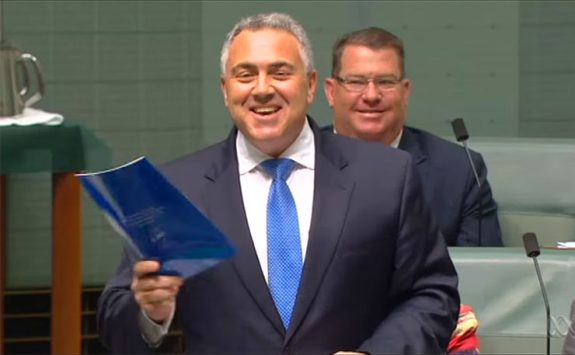No courage, no vision, no plan

In 1946, after World War II, gross debt in Australia peaked at 120% of GDP. Despite this, in 1949, the government of the day had the courage and foresight to embark on the largest construction project undertaken in Australia, the Snowy Mountains Hydro Scheme.
The Scheme cost $1.16 billion and was completed in 1974. By then, gross debt had declined to around 8 per cent of GDP.
In the 25 years it took to build, more than 100,000 people from over 30 countries came to work in the mountains to make true a vision of diverting water to farms to feed a growing nation and to build power stations to generate renewable electricity for homes and industries.
The project is often used as an example for multiculturalism, having employed thousands of migrant engineers and labourers. Their influence radically changed Australian culture for the better in the years that followed.
Sixteen major dams, seven major power stations (two underground), a pumping station, 145kms of inter-connected trans-mountain tunnels and 80kms of aqueducts were constructed. Even before the Scheme was completed, it was named as one of the civil engineering wonders of the modern world. The Snowy Mountains Engineering Corporation now sells its engineering knowledge overseas.
Today, Snowy Hydro continues to play a vital role in the growth and the development of Australia’s national economy, by diverting water that underwrites over $3 billion in agricultural produce and by generating clean renewable energy.
Snowy Hydro currently provides around 32% of all renewable energy that is available to the eastern mainland grid of Australia, as well as providing fast response power to light up the morning and evening rush hours of Sydney, Brisbane, Canberra, Melbourne and Adelaide. Water flow from dams is much easier to turn off than a coal-fired power station.
Had the government of the day worried about the “debt and deficit” disaster, this nation-changing project may not have gone ahead. Thankfully, they realised the future return on their investment and the immediate advantages of the employment and skills training it provided.
Abbott had his chance to be part of a similar boost to our nation with the NBN. He chose instead to go with the rhetoric contained in the daily talking points provided by the red-shoe wearing Mark Textor and destroy this productivity enhancing reform for no reason other than he wants to be able to say he achieved a surplus just like John Howard. He patently doesn’t understand its potential. Gillard started it so it must be destroyed.
Tony’s wants his big contribution to be more roads whether we want them or not.
He seems oblivious to the heat island consequences of thousands of kilometres of bitumen, the pollution caused by more cars on the road, and the effect on climate change from using fossil fuels.
He doesn’t care about cost benefit analyses or the priorities outlined by Infrastructure Australia or the lack of parking in the cities.
He doesn’t seem to understand that if we got cars off the road by investing in urban public transport it would free it up for road freight or that if we built a high speed rail between Melbourne and Brisbane that it would free up the rail lines for rail freight and the airports for air freight.
Climate change think tank Beyond Zero Emissions found that a high-speed rail network on Australia’s east coast could be built for $84 billion and the system would be faster, cheaper and cleaner than air travel. To put this in perspective, the budget allocated $36 billion over 5 years to be spent “building the roads of the 21st century”. State and federal governments spend a combined $18 billion each year on roads.
HSR would allow people to travel from Sydney to Melbourne in two hours and 44 minutes, and Sydney to Brisbane in two hours and 37 minutes – potentially faster than flying once you take into account time at the airport.
Its design envisages a network powered by 100 per cent renewable energy, reducing greenhouse gas emissions from regional travel by 150 million tonnes of carbon dioxide over 40 years.
The rail link would also turbocharge regional development.
“High-speed rail will allow people to live in cities like Shepparton and Goulburn but commute to Sydney or Melbourne for work,” CEO Dr Bygrave said.
“It would allow people to live outside of urban cities but still work in them. It’s a pretty important nation-building exercise.”
This would make living in regional areas more attractive, and in turn alleviate pressure on house prices in capital cities.
“High-speed rail would revolutionise interstate travel, and would also be an economic game-changer for dozens of regional communities along its path. That’s why the politicians need to exercise vision and think way beyond the current political cycle,” Mr Albanese said.
The HSR advisory group was disbanded after Abbott won the election and the funding for long term planning was cut in the budget.
While politicians continue to foolishly and needlessly pursue a surplus, we are committing intergenerational theft by refusing to invest in the infrastructure they will need in the future.
This government has no courage, no vision, and no plan.
Like what we do at The AIMN?
You’ll like it even more knowing that your donation will help us to keep up the good fight.
Chuck in a few bucks and see just how far it goes!
Your contribution to help with the running costs of this site will be gratefully accepted.
You can donate through PayPal or credit card via the button below, or donate via bank transfer: BSB: 062500; A/c no: 10495969










